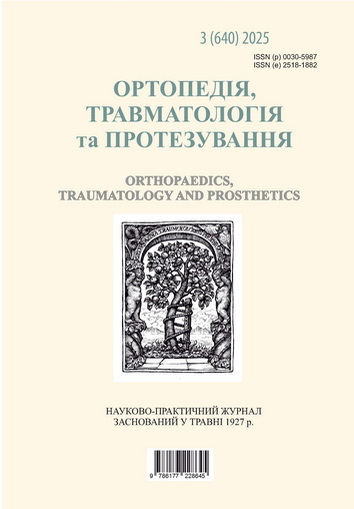HISTOLOGICAL CHANGES IN ADJACENT INTERVERTEBRAL DISCS IN A RAT MODEL OF NUCLEUS PULPOSUS INJURY AND SPINAL NERVE COMPRESSION
DOI:
https://doi.org/10.15674/0030-59872025337-46Keywords:
Іintervertebral disc degeneration, rat, spinal nerve compression, degenerative lumbar disease, adjacent segment diseaseAbstract
The prevalence of decompression and stabilization in the thoracic and lumbar spine (LS) is constantly increasing due to the high incidence of degenerative spine diseases among the working-age population. Aim: To analyze histological changes in rats in which the condition of LS was experimentally reproduced as in patients with spinal nerve compression before and after performing decompression and stabilization of the spine. Methods. The study was conducted using 19 white rats, in which the nucleus pulposus in the intervertebral disc was destroyed at the LV–LVІ l evel. In Model 1, at the level of the damaged disc, the right spinal nerve was ligated with two double knots of suture material. In Model 2, the LV and LVI vertebral bodies were bilaterally fixed with two metal staples, pressing them on the root area. Results. No signs of inflammation were detected in any of the rats. Degenerative changes were recorded in the adjacent cranial and caudal intervertebral discs, but there was no significant difference in the scores between the adjacent intervertebral discs, both in the case of a general assessment and separately for the annulus fibrosus and the nucleus pulposus. The values obtained were ≈ 6.5 and ≈ 5 points, respectively, for the model. The sum of the scores for the annulus fibrosus of the degenerative disc of Model 1 was significantly higher compared to both adjacent discs (p = 0.016; p = 0.026), compared to the corresponding values for the cranial or caudal disc of Model 2, no difference was detected. In both models, Wallerian degeneration was detected in the more distal areas of the nerves. Conclusions: Degenerative changes occur in adjacent discs in a rat model of spinal nerve compression and intervertebral disc nucleus pulposus injury. This provides an opportunity to use this model to study treatments for disc degeneration in patients with neurological complications after spinal decompression and stabilization.
Downloads
How to Cite
Issue
Section
License
Copyright (c) 2025 Oleksandr Barkov, Valentyna Maltseva, Olga Nikolchenko, Zinayda Danyshchuk, Kateryna Samoylova

This work is licensed under a Creative Commons Attribution 4.0 International License.
The authors retain the right of authorship of their manuscript and pass the journal the right of the first publication of this article, which automatically become available from the date of publication under the terms of Creative Commons Attribution License, which allows others to freely distribute the published manuscript with mandatory linking to authors of the original research and the first publication of this one in this journal.
Authors have the right to enter into a separate supplemental agreement on the additional non-exclusive distribution of manuscript in the form in which it was published by the journal (i.e. to put work in electronic storage of an institution or publish as a part of the book) while maintaining the reference to the first publication of the manuscript in this journal.
The editorial policy of the journal allows authors and encourages manuscript accommodation online (i.e. in storage of an institution or on the personal websites) as before submission of the manuscript to the editorial office, and during its editorial processing because it contributes to productive scientific discussion and positively affects the efficiency and dynamics of the published manuscript citation (see The Effect of Open Access).














